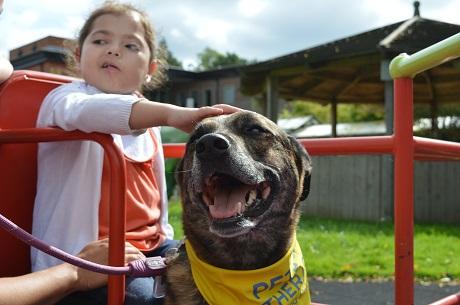
Published on: 19/09/19
Animals can play a big part in therapy. Here we look at one dog, Cal, making community visits to children with acquired brain injury.

Published on: 19/09/19
Through Pets As Therapy (PAT) Cal and his owner Colette have been visiting The Children’s Trust specialist rehabilitation centre for brain injury every fortnight since March 2019.
They walk around the grounds interacting with children that show an interest in Cal. Some like to touch him, others just to watch and you can see the joy Cal brings.
Before being able to make community visits, Cal was assessed and specially trained. PAT dogs have a rigorous assessment process that includes a detailed application, provision of references and proof of vaccinations. Once he passed the first stage, there was a face-to-face interview for Colette, assessment and tests with an experienced PAT assessor. During the assessment Cal needed to demonstrate that he was calm, obedient, people-friendly and very well behaved.
Cal also goes for training weekly. He has passed the Kennel Club Good Citizens Dog Scheme Awards in Bronze, Silver and Gold. Colette and Cal are now working towards the platinum award.
When asked what benefits Cal brings during their visits, Colette said: “Disability can increase feelings of isolation and separation. A pet can sometimes reach through barriers to bring comfort and love to children. Animals can touch us in a way that people can’t, they are different, and for some this unconditional affection is very soothing and welcome.”
Colette explains how she’ll watch a child’s behaviour, as some are unable to verbalise or express their feelings. “I can see signs that range from a definite interest in Cal to full blown joy that a dog has come into their midst,” she said. “That is what I enjoy, their simple pleasure in an animal and Cal’s interest or interaction with the children. We met one little boy, very young (two - three years) who was scared of Cal when we first met, but with gentle reassurance from his mother he gradually learnt to not be afraid and to pat and stroke Cal. After the third visit he liked Cal so much that he cried when Cal and I had to leave.”
Although some children may not be able to reach out and touch Cal, Colette notices how the children follow the dog’s movements with their eyes. “Other children love to stroke him and feel the different textures of his fur. Some children even enjoy walking him a short distance!” said Colette.
Describing what makes Cal an excellent PAT dog, Colette said: “Cal is a relaxed and friendly dog who likes both adults and children. He is not perturbed or startled by new people, situations or loud noises. He is very patient and happy to be stroked and petted for long periods. He is also obliging and will do his best to obey requests. He can also do a number of little tricks which the children like very much – especially roll-over.”
Colette did say that even though they visit the children, all the staff love to say hello to Cal and he gets lots of attention and smiles from them too!
You can read more about the positive effects of animal therapy here.